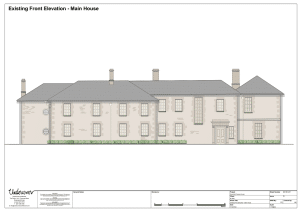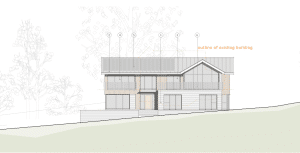Joe has an extensive background in the planning industry with ten years of local authority development management experience before joining McLoughlin Planning in 2019. He has worked on a wide variety of developments, including small, medium and large-scale residential, commercial, leisure, retail, equestrian and agricultural. Joe also undertakes work as a Planning Inspector on a contract basis, which provides McLoughlin Planning with a unique insight into the planning appeal process.
He has a particular interest in development management; listed buildings/historic environment; Green Belt sites.
Joe has successfully secured the following developments on behalf of his clients:
In his spare time Joe enjoys playing golf, spending time with family, European city breaks and watching live sport (either in the stadium or in the pub!)

McLoughlin Planning with special thanks to Undercover Architecture, who worked with us on this project and provided the drawings, are pleased to have gained planning permission and listed building consent for the Grade II listed private house, Somerford Keynes House, in the Cotswolds.
Listed building features required for consent
The key areas that the owner wanted consent for were:
Contemporary Changes to the Main House
Alterations to the main house included in this recent granted permission were an addition of a French door with side lights to the side elevation, installation of rooflights in the roof valley between rafters (blocking up of a staircase to the basement with new staircase constructed to access cellar), and other minor workings such as the removal of modern partitions to allow for a more open plan space. In 2011, permission was granted for a stone porch to be added. This time round, a contemporary frameless glazed porch extension, complimented with a living green roof with pressed metal oversailing porch has been proposed to the side of the building to enhance a light and elegant feel to the house.
Family Orientated Outbuildings
In order for the outbuildings to have a more homely feel, internal changes were made to create larger spatial areas, including a raised ceiling, to accommodate for more bedrooms and a cosier setting at Kings Cottage. Proposed changes to the Coach House consist of a casement window to allow for an en-suit, which is located on the first floor to the linking section of the building. Originally, this wasn’t the case to be implemented, but due to concerns of excessive fenestration, the size of roof lights had to be changed and the dormer windows to be discarded. To allow for a modern way of travel and a tranquil Cotswold setting by the pool, an EV charging point and several air source heat pumps (ASHP), that are to be screened with timber for aesthetic purposes, were proposed.
Maintaining Historic Value and Consideration of Planning Policies
Overall, the proposed scheme has considered the historic value and beauty of the building’s original structure and the modern elements added to it over the years, therefore justifying that the new considered extensions and alterations granted for this permission will preserve the listed building for years to come. Additionally, careful considerations were sought out to ensure the development was aligned with legislation and policies, such as Section 16 of the NPPF (National Planning Policy Framework) for works to take place.
I’m a Listed Building Owner – When do I need to Acquire After Consent?
If you are a listed building owner and are wondering whether and/or when you need to acquire for listed building consent, please get in contact and one of our planning consultants will be able to assist. Additionally, please view our article here about when to acquire for listed building consent.
Joe Seymour – Associate Director
E: joe.seymour@mplanning.co.uk
T: 01242895008

McLoughlin Planning has successfully obtained planning permission to demolish an existing dwelling and construct a larger replacement dwelling in the Tewkesbury Borough. The site’s location within the Cotswolds National Landscape (formerly the Cotswolds Area of Outstanding Natural Beauty) and particularly the Gloucester-Cheltenham Green Belt presented significant challenges to achieving the client brief. In partnership with Coombes:Everitt Architects and Willder Ecology –we secured the demolition of a dilapidated dwelling dating from the 1920s, and the construction of a larger contemporary replacement dwelling.
Defining the term ‘materially larger’ in the Green Belt? A holistic comparison can be key
Councils often provide inconsistent guidance or, more challenging still, no guidance at all in terms of the size of a replacement building one is allowed to construct in the Green Belt. The key planning policy test for this application was that the new dwelling could not be “materially larger” than the existing dwelling, which inevitably raised the question: what is meant by this subjective term?
McLoughlin Planning successfully negotiated with the case officer to agree that the proposed dwelling was not materially larger, thus allowing planning permission to be granted. One of the key lessons learnt from this project is that it is not simply a question of comparing the existing and proposed floor areas. The Council will also take into consideration the differences in height, footprint, and volume, in addition to floor area, when deciding whether a replacement building is “materially larger”. Providing a holistic comparison can be the difference between approval and refusal.
I own a property in the Green Belt – how can I obtain planning permission for my project?
We are absolutely delighted with the positive outcome on this project, which will turn an almost unusable dwelling into a well-designed home. The team at McLoughlin Planning are very experienced in the nuances surrounding these types of development projects and navigating the complexities of challenging land designations. If you have a project that might benefit from our expertise, then get in contact with one of our planning consultants to find out how we can best assist you.
Joe Seymour – Associate Director
E: joe.seymour@mplanning.co.uk
T: 01242895008
Image source: Coombes: Everitt Architects (2024)
Project Team:
McLoughlin Planning (Planning consultants)
Coombes:Everitt architects (Architects)
Willder Ecology (Ecologist)
If you are interested in finding out how we can help you please get in touch